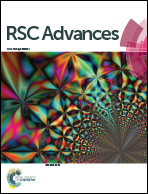Facile reversible LSPR tuning through additive-induced self-aggregation and dissemination of Ag NPs: role of cyclodextrins and surfactants
Abstract
Tuning the optoelectronic properties by controlling coupled surface plasmon modes in metal nanomaterials is a major challenge. Several methods have been developed for localized surface plasmon resonance (LSPR) tuning, which are generally provoked by the self-assembly of a certain molecule (e.g. protein or viologen) that cause aggregation of nanoparticles. Here, we have developed a new, simple method that is applied on dilute cetyltrimethylammonium bromide (CTAB)-stabilized Ag NPs for reversible LSPR tuning through additive-induced formation and subsequent dispersion of self-aggregates. Addition of cyclodextrin (α- or β-) results in a decrease of the surface charge of NPs by taking away CTAB from the nanoparticle surface through formation of an inclusion complex. The slow formation of self-aggregates of Ag NPs is due to the gradual decrease in surface charge, which results in a large red-shifting of the LSPR band (436 nm to 537 nm). Subsequent addition of different types of surfactants alters the surface charge by re-attachment of stabilizer and results in dispersion of self-aggregates with blue-shifting of the LSPR band (537 nm to 420 nm). This efficient formation and break down of self-aggregates are monitored by dynamic light scattering (DLS) and transmission electron microscopy (TEM) measurements and are correlated with the alteration of the plasmonic absorption band. Variation in surface charge of Ag NPs is followed by zeta-potential measurements. This easy approach to control the plasmon absorption position can be very significant in applications such as sensing and optoelectronic devices.


 Please wait while we load your content...
Please wait while we load your content...